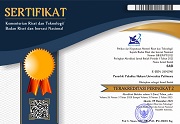The Effectiveness of Diversion Through Restorative Justice For Handling Children In The East Java Police
 ), Evi Kongres(2), Asri Gresmelian Eurike Hailitik(3), Pandu Satriawan Zainulla(4)
), Evi Kongres(2), Asri Gresmelian Eurike Hailitik(3), Pandu Satriawan Zainulla(4)
(1) Faculty of Law 17 Agustus 1945 Surabaya University, Surabaya, Indonesia
(2) Faculty of Law 17 Agustus 1945 Surabaya University, Surabaya, Indonesia
(3) Faculty of Law 17 Agustus 1945 Surabaya University, Surabaya, Indonesia
(4) Faculty of Law 17 Agustus 1945 Surabaya University, Surabaya, Indonesia
 Corresponding Author
Corresponding Author
Abstract
Introduction: Children are the next generation of the nation who must be protected in order to grow up properly. Handling children's cases through the Juvenile Criminal Justice System has devastating impacts on children's futures.
Purposes of the Research: This study aims to analyze the effectiveness of handling children's cases through diversion in the East Java Regional Police and analyze obstacles to handling children's cases through diversion so that solutions are found to achieve maximum diversion implementation as mandated by the Children's Criminal Justice System Law.
Methods of the Research: This type of research is sociolegal research with a statutory approach, a conceptual approach, and a comparison approach, namely Law Number 11 of 2012 concerning the Juvenile Criminal Justice System.
Results of the Research: The results showed that of the five police and police in the East Java Regional Police area, it showed that not 50% of the handling of children's cases had been successfully resolved through diversion. The causative factors include the non-achievement of the consent of the victim's child and his family. Therefore, the condition of consent of the victim's child and his family in Article 9 paragraph (2) must be abolished because Article 7 paragraph (2) of Law Number 11 of 2012 does not require the consent of the victim's child and his family. In practice is the main obstacle to achieving diversion, should be eliminated in the best interest of the child in accordance with the principles of the Convention on the Rights of the Child.Keywords
DOI
10.47268/sasi.v29i1.1190
Published
2023-03-11
How To Cite
@article{SASI1190,
author = {Erny Setyorini and Evi Kongres and Asri Gresmelian Hailitik and Pandu Zainulla},
title = {The Effectiveness of Diversion Through Restorative Justice For Handling Children In The East Java Police},
journal = {SASI},
volume = {29},
number = {1},
year = {2023},
keywords = {Effectiveness of Handling Child Cases; Diversion and Restorative Justice; East Java Regional Police},
abstract = {Introduction: Children are the next generation of the nation who must be protected in order to grow up properly. Handling children's cases through the Juvenile Criminal Justice System has devastating impacts on children's futures.Purposes of the Research: This study aims to analyze the effectiveness of handling children's cases through diversion in the East Java Regional Police and analyze obstacles to handling children's cases through diversion so that solutions are found to achieve maximum diversion implementation as mandated by the Children's Criminal Justice System Law.Methods of the Research: This type of research is sociolegal research with a statutory approach, a conceptual approach, and a comparison approach, namely Law Number 11 of 2012 concerning the Juvenile Criminal Justice System.Results of the Research: The results showed that of the five police and police in the East Java Regional Police area, it showed that not 50% of the handling of children's cases had been successfully resolved through diversion. The causative factors include the non-achievement of the consent of the victim's child and his family. Therefore, the condition of consent of the victim's child and his family in Article 9 paragraph (2) must be abolished because Article 7 paragraph (2) of Law Number 11 of 2012 does not require the consent of the victim's child and his family. In practice is the main obstacle to achieving diversion, should be eliminated in the best interest of the child in accordance with the principles of the Convention on the Rights of the Child.},
issn = {2614-2961}, pages = {59--74} doi = {10.47268/sasi.v29i1.1190},
url = {https://fhukum.unpatti.ac.id/jurnal/sasi/article/view/1190}
}
Journal Article
Danawiharja, Yusuf Luqita. “Analisis Yuridis Penerapan Diversi Terhadap Anak Yang Berhadapan Dengan Hukum Dihubungkan Dengan Peraturan Mahkamah Agung Nomor 4 Tahun 2014 Tentang Pedoman Pelaksanaan Diversi Dalam Sistem Peradilan Pidana Anak.” Aktualita (Jurnal Hukum), 2020. https://doi.org/10.29313/aktualita.v0i0.6325.
Fitri Jayanti Eka Putri. “Perlindungan Hukum Terhadap Anak Berkonflik Dengan Hukum Dalam Sistem Peradilan Pidana Anak” 3, no. 1 (2021): 115.
Harefa, Beniharmoni. “Mediasi Penal Sebagai Bentuk Diversi Dalam Penyelesaian Perkara Pidana Anak Berbasis Keadilan Restoratif.” Jurnal Komunikasi Hukum (JKH) 4, no. 1 (2018). https://doi.org/10.23887/jkh.v4i1.13657.
Otto Yudianto, Teguh Prasetyo, Ismail Pettanasse. “Diversion policy against children in conflict with internal law serious crime based on justice value.” Technium Social Sciences Journal 21 (2021): 487–91.
Prayitno, Kuat Puji. “Restorative Justice Untuk Peradilan Di Indonesia (Perspektif Yuridis Filosofis dalam Penegakan Hukum In Concreto).” Jurnal Dinamika Hukum 12, no. 3 (2012). https://doi.org/10.20884/1.jdh.2012.12.3.116.
Putri, Nurfa Caesarini. “Pendekatan Keadilan Restoratif dalam Penanganan Tindak Pidana Pencurian yang Dilakukan oleh Anak.” Jurist-Diction 4, no. 5 (2021). https://doi.org/10.20473/jd.v4i5.29825.
Salundik. “Anak Yang Berkonflik Dengan Hukum.” Anak Yang Berkonflik Dengan Hukum Dalam Perspektif Penegakan Hukum 5, no. 1 (2020): 629.
Setyorini, Erny Herlin, Sumiati Sumiati, dan Pinto Utomo. “Konsep Keadilan Restoratif Bagi Anak Yang Berkonflik Dengan Hukum Dalam Sistem Peradilan Pidana Anak.” DiH: Jurnal Ilmu Hukum 16, no. 2 (2020). https://doi.org/10.30996/dih.v16i2.3255.
Setyowati, Dewi. “Memahami Konsep Restorative Justice sebagai Upaya Sistem Peradilan Pidana Menggapai Keadilan.” Pandecta Research Law Journal 15, no. 1 (2020). https://doi.org/10.15294/pandecta.v15i1.24689.
Subagiono, Yoyok, Teguh Prasetyo, dan Otto Yudianto. “The Nature of Termination of Criminal Criminal Attendance Based On Restorative Justice.” International Journal of Scientific and Research Publications (IJSRP) 9, no. 12 (2019). https://doi.org/10.29322/ijsrp.9.12.2019.p9655.
Book
Ibrahim, Jhonny. Teori dan Metodologi Penelitian Hukum Normatif. Cetakan ke. Malang: Bayumedia Publishing, 2012.
Marzuki, Peter Mahmud. Metode Penelitian Hukum Edisi Revisi. Jakarta: Prenada Group, 2016.
Nashriana. Perlindungan Hukum Pidana Bagi Anak di Indonesia. Jakarta: RajaGrafindo Persada, 2012.
Teguh, Harrys Pratama. Hukum Pidana Perlindungan Anak di Indonesia, Teori dan Perlindungan Anak di Indonesia. Bandung: CV Pustaka Setia, 2020.
Tridiatno, Yoachim Agus. Keadilan Restoratif. Yogyakarta: Cahaya Atma Pustaka, 2015.
Warner, Kate. Juveniles in the Criminal Justice System. Dalam Geor. Sydney and London: Pluto Press, 1987.
Zehr, Howard. The Little Book of Restorative Justice. Good Books, 2002.
Thesis, Web Page, and Others
“Interview with Dinik Suciharti, Head of Women and Child Protection Unit, East Java Regional Police,” 2022.
| Dublin Core | PKP Metadata Items | Metadata for this Document | |
| 1. | Title | Title of document | The Effectiveness of Diversion Through Restorative Justice For Handling Children In The East Java Police |
| 2. | Creator | Author's name, affiliation, country | Erny Herlin Setyorini; Faculty of Law 17 Agustus 1945 Surabaya University, Surabaya; Indonesia |
| 2. | Creator | Author's name, affiliation, country | Evi Kongres; Faculty of Law 17 Agustus 1945 Surabaya University, Surabaya; Indonesia |
| 2. | Creator | Author's name, affiliation, country | Asri Gresmelian Eurike Hailitik; Faculty of Law 17 Agustus 1945 Surabaya University, Surabaya; Indonesia |
| 2. | Creator | Author's name, affiliation, country | Pandu Satriawan Zainulla; Faculty of Law 17 Agustus 1945 Surabaya University, Surabaya; Indonesia |
| 3. | Subject | Discipline(s) | |
| 3. | Subject | Keyword(s) | Effectiveness of Handling Child Cases; Diversion and Restorative Justice; East Java Regional Police |
| 4. | Description | Abstract | Introduction: Children are the next generation of the nation who must be protected in order to grow up properly. Handling children's cases through the Juvenile Criminal Justice System has devastating impacts on children's futures.Purposes of the Research: This study aims to analyze the effectiveness of handling children's cases through diversion in the East Java Regional Police and analyze obstacles to handling children's cases through diversion so that solutions are found to achieve maximum diversion implementation as mandated by the Children's Criminal Justice System Law.Methods of the Research: This type of research is sociolegal research with a statutory approach, a conceptual approach, and a comparison approach, namely Law Number 11 of 2012 concerning the Juvenile Criminal Justice System.Results of the Research: The results showed that of the five police and police in the East Java Regional Police area, it showed that not 50% of the handling of children's cases had been successfully resolved through diversion. The causative factors include the non-achievement of the consent of the victim's child and his family. Therefore, the condition of consent of the victim's child and his family in Article 9 paragraph (2) must be abolished because Article 7 paragraph (2) of Law Number 11 of 2012 does not require the consent of the victim's child and his family. In practice is the main obstacle to achieving diversion, should be eliminated in the best interest of the child in accordance with the principles of the Convention on the Rights of the Child. |
| 5. | Publisher | Organizing agency, location | Faculty of Law, Universitas Pattimura |
| 6. | Contributor | Sponsor(s) | Faculty of Law 17 Agustus 1945 Surabaya University, Surabaya |
| 7. | Date | (YYYY-MM-DD) | 2023-03-11 |
| 8. | Type | Status & genre | Peer-reviewed Article |
| 8. | Type | Type | |
| 9. | Format | File format | |
| 10. | Identifier | Uniform Resource Identifier | https://fhukum.unpatti.ac.id/jurnal/sasi/article/view/1190 |
| 10. | Identifier | Digital Object Identifier | 10.47268/sasi.v29i1.1190 |
| 11. | Source | Title; vol., no. (year) | SASI; Volume 29 Issue 1, March 2023 |
| 12. | Language | English=en | en |
| 13. | Relation | Supp. Files | |
| 14. | Coverage | Geo-spatial location, chronological period, research sample (gender, age, etc.) | |
| 15. | Rights | Copyright and permissions | Copyright: Authors who publish their manuscripts in this Journal agree to the following conditions: 1. The copyright in each article belongs to the author, as well as the right to patent. 2. Authors can enter into separate, additional contractual arrangements for the non-exclusive distribution of the journal's published version of the work (e.g., post it to an institutional repository or publish it in a book), with an acknowledgment of its initial publication in this journal. 3. Authors are permitted and encouraged to post their work online (e.g., in institutional repositories or on their website) before and during the submission process, as it can lead to productive exchanges, as well as earlier and greater citation of published work. 4. Authors have the right to self-archiving of the article (Author Self-Archiving Policy)
License: The SASI Journal is disseminated based on the Creative Commons Attribution-NonCommercial 4.0 International license terms. This license allows anyone to copy and redistribute this material in any form or format, compose, modify, and make derivatives of this material for any purpose. You cannot use this material for commercial purposes. You must specify an appropriate name, include a link to the license, and certify that any changes have been made. You can do this in a way that is appropriate but does not imply that the licensor supports you or your use.
|
Copyright (c) 2023 Erny Herlin Setyorini, Evi Kongres, Asri Gresmelian Eurike Hailitik, Pandu Satriawan Zainulla
License URL: https://creativecommons.org/licenses/by-nc/4.0

 : 2452 times
: 2452 times Download : 1326 times
Download : 1326 times
















